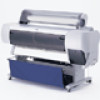Epson Stylus Pro 10000 - Archival Ink Technical Brief (EPSON Archival Inks) - Page 1
Epson Stylus Pro 10000 - Archival Ink - Stylus Pro 10000 Print Engine Manual
 |
View all Epson Stylus Pro 10000 - Archival Ink manuals
Add to My Manuals
Save this manual to your list of manuals |
Page 1 highlights
Contents EPSON Archival™ Inks are used in the professional "P"-series EPSON Stylus Photo printers and in select models of the professional graphics EPSON Stylus Pro models. This technical brief will provide detailed information on the following topics: EPSON Archival Ink Technology ▼ Comparison of different types of ink ▼ EPSON MicroCrystal Encapsulation Technology EPSON Archival Ink Technology-Comparison of different types of ink EPSON Archival Ink Technology uses pigment inks, but includes a breakthrough technology that combines the advantages of conventional pigment inks with the advantages of dye inks. The key differences between the types of inks are: Key Differences EPSON Archival Inks Typical use Lightfastness Photography (Fine Art and Print for Pay) and wide format ink jet printer market where archival printing and Photo Quality output is required High lightfastness, over 100 years Short-Term Stability Highly stable, with nominal short-term color shifting Waterfastness Extremely waterfast Color Gamut and Gloss Durability Media choices Superb color gamut and gloss due to even reflection of inks when using EPSON RC (Resin Coated) media Good durability because pigments are coated with resin and are fixed on specialty media Wide media selection: matte, watercolor, and RC photo type papers Conventional Pigment Inks Wide format ink jet printer market for outdoor signage; NOT optimal for photography Dye Inks Standard with desktop ink jet printers; photography, presentations, artwork, etc. High lightfastness, over 100 years Highly stable, with nominal short-term color shifting Very waterfast Lowest color gamut and dull (no gloss) prints due to uneven reflection and high scattering Susceptible to scratching because pigment particles sit on top of the paper Poor to excellent lightfastness Good stability, with minimal short-term color shifting Waterfast on many specialty papers (not plain paper) Superb color gamut and gloss due to even reflection of inks from the paper Extremely durable, since inks are absorbed into the paper Limited media selection: limited to signage media only Greatest media selection: plain, matte, and RC photo and high gloss paper types As the chart indicates, the EPSON Archival Inks combine the lightfastness, short-term stability, and waterfastness advantages of conventional pigment inks with the color gamut, durability, and wide media selection advantages of dye inks. 1 Lightfastness ratings over 100 years before noticeable fading occurs, under a glass frame in normal indoor fluorescent lighting conditions, when using Epson Archival Inks and Epson Fine Art Papers. Lightfastness ratings based on accelerated testing of prints on EPSON special media, displayed indoors, under glass. Actual print stability will vary according to image, display conditions, light intensity, humidity, and atmospheric conditions. Epson does not guarantee longevity of prints. Ratings do not estimate the durability of the paper itself. For maximum print life, display all prints under glass or laminations or properly store them. EPSON Sales Training EPSON and EPSON Stylus are registered trademarks of Seiko Epson Corporation. Other trademarks are the property of their respective owners. 11/00







